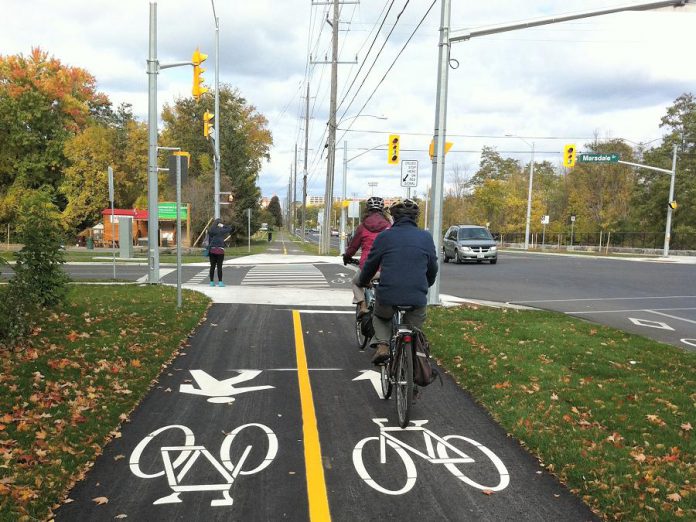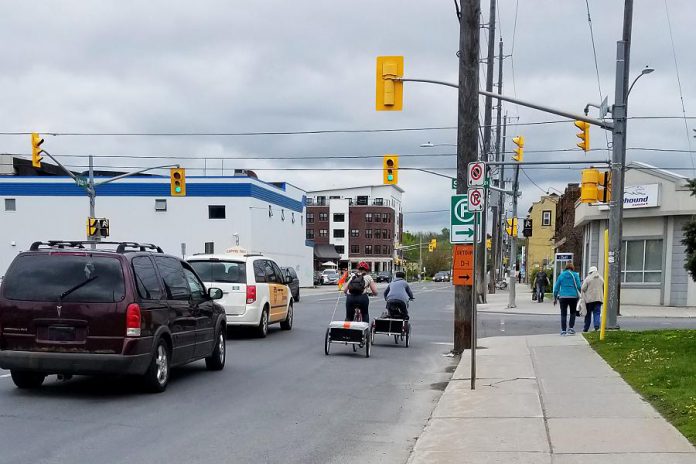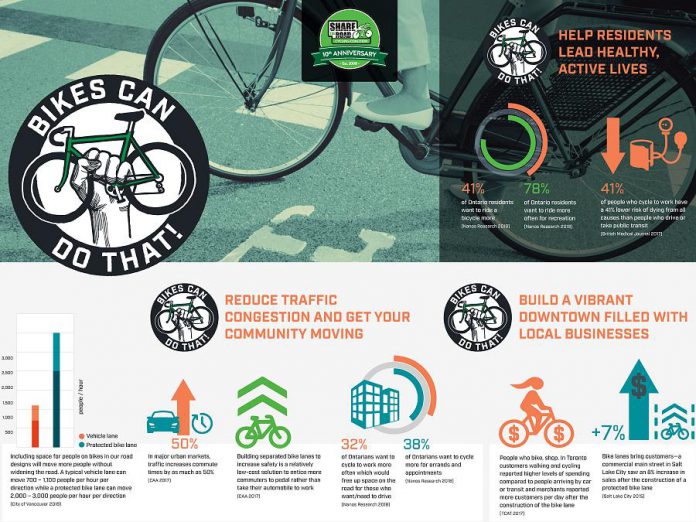
As we begin 2020, I would like to wrap up GreenUP’s #BikesCanDoThat series with some hopeful feelings of possibility, for you and for our community.
Let’s examine how a shift towards using a bike for daily trips around town can work to decrease your personal emissions, and how a shift towards creating an even more bike-friendly Peterborough can help our region move towards its emission targets for 2030 and 2050.
Solutions that address emissions connected to transportation on our roads are vitally important.
The latest data, captured in 2017, shows that Canada has reduced annual emissions by only two per cent from 2005 levels. These levels have not remained stable across sectors, however. Increases in emissions in the oil, gas, and transportation sectors are offsetting decreases made by other sectors, such as electricity and heavy industry.
Also interesting to note from this national data is that transportation emissions are primarily related to personal transportation (light-duty vehicles and trucks) and heavy-duty vehicles. The number of these vehicles on our roads has increased 37 per cent since 2005.
A similar story holds true for Ontario, where personal vehicles are responsible for almost 20 per cent of our total emissions — an amount equal to that of the heavy industry or buildings sectors in the province.
Together, these numbers show that personal transportation contributes significantly to our overall emissions, and that past and current transportation trends do not support our efforts to address climate change. We need to reverse these trends.

The 2017 Annual Greenhouse Gas Progress Report from the Environmental Commissioner of Ontario advised that “targeting these emissions will require a multi-pronged strategy involving better urban planning, greater uptake of low-emission vehicles, and greater participation in active modes of transportation.”
Shifts toward active transportation are in fact recognized by experts as one of the solutions. The UN Intergovernmental Panel of Climate Change (IPCC) identified a change towards walking and cycling from driving for short distances by as a way to save energy and mitigate climate change.
In the first column of this series, we identified that a large number of trips in Peterborough are relatively short; transportation surveys show that we travel a median distance of 2.7 kilometres per trip on weekdays, and 73 per cent of all our trips made are less than five kilometres.
Five kilometres is generally considered to be a pleasantly bikeable distance. For the individual able to make the shift from driving a vehicle to riding a bike, they would save 1.25 kilograms of CO2 per trip. If this was a daily one-way commute distance, over the course of the year, they will have saved approximately 627.5 kilograms of CO2.
With so many of our trips falling within this bikeable range, we can see how biking — alongside walking, taking transit, and electric vehicles — can be a realistic and beneficial way for many individuals to decrease their carbon footprint.
Collectively, a shift towards cycling would also help our region reach emissions targets set in the 2016 Greater Peterborough Area Climate Change Action Plan and help our city address the climate emergency declared in 2019.

After Vancouver declared a climate emergency in early 2019, they quickly moved to accelerate their targets for walking, cycling, and transit use. They are now aiming to have two-thirds of trips taken by these modes by 2030, rather than 2040. Their plan includes land-use planning that continues to focus on walkable, complete communities, improvements to transit capacity and efficiency, and creating better connected active transportation networks.
Peterborough could do similarly.
Creating a network of active transportation infrastructure (e.g., sidewalks, bike lanes, trails) can have a positive effect on ridership. In 2016, researchers in Quebec demonstrated clear links between bicycle infrastructure accessibility and the choice to bike. They took the study a step further and determined that for an increase of seven per cent in the length of Montreal’s bike network they observed a reduction of close to two per cent greenhouse gas emissions.
The Environmental Commissioner’s 2017 report echoes these findings. The report cites plans to increase the network of cycling infrastructure in Ontario as one of the nine most important developments in climate change policy.
Of course, addressing personal transportation emissions will require a comprehensive plan that aims for mixed land-use and improved access to services and infrastructure.
In their 2019 Energy Conservation Progress Report, the Environmental Commissioner’s Office forecasted that “Land use planning that follows best practices can reduce congestion and pollution by making travel in private cars less necessary, and by making alternatives more practical, more pleasant and more convenient. This is a long-term process. Decisions made today lock in energy, growth and transport patterns for decades.”
2020 begins a decade of key decisions that will impact our ability to fight climate change and meet our 2030 and 2050 targets. As you consider your personal resolutions this year, and as we all consider how to address the climate emergency as a city, rest assured that bikes are an essential tool to decreasing our greenhouse gas emissions. Bikes can do that!

In 2018 the provincial voice for cycling, Share the Road, released an infographic titled Bikes Can Do That! It details seven benefits that can be achieved when bikes become the daily vehicle of choice for more people in your community.
Throughout 2019, GreenUP explored the benefits that can be achieved by a city and its residents, when it commits to valuing the bike as a significant, useful, (and fun) mode of transportation, through the #BikesCanDoThat series. Previous stories in the series are:
- Want to reduce traffic congestion? Bikes can do that.
- Want to build a vibrant downtown? Bikes can do that.
- Want to promote active living? Bikes can do that.
- Want to attract tourists? Bikes can do that.
- Want to make life more affordable and equitable? Bikes can do that.
- Want to improve road safety? Bikes can do that.



























